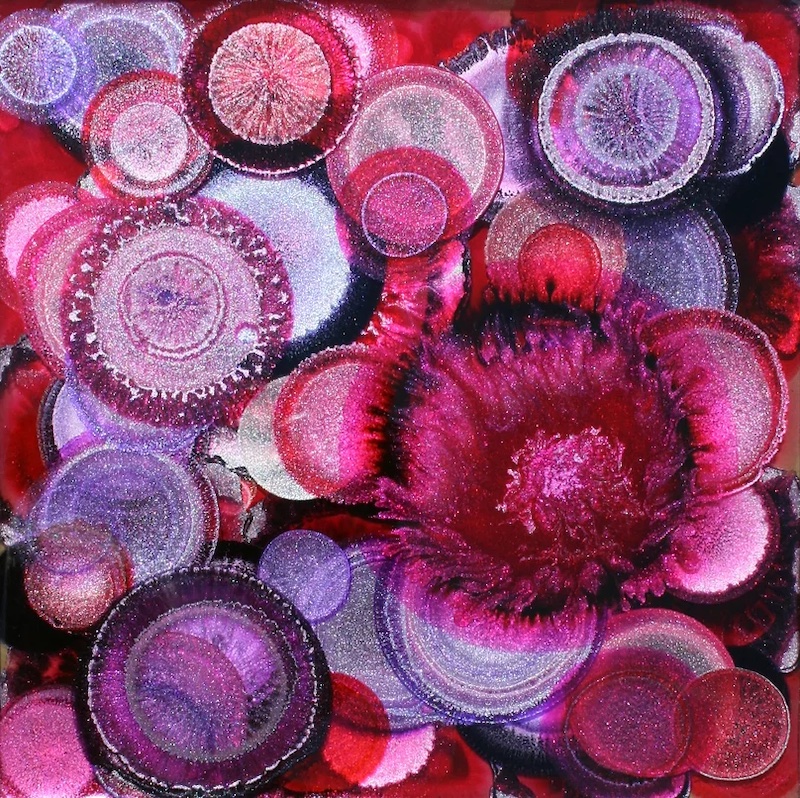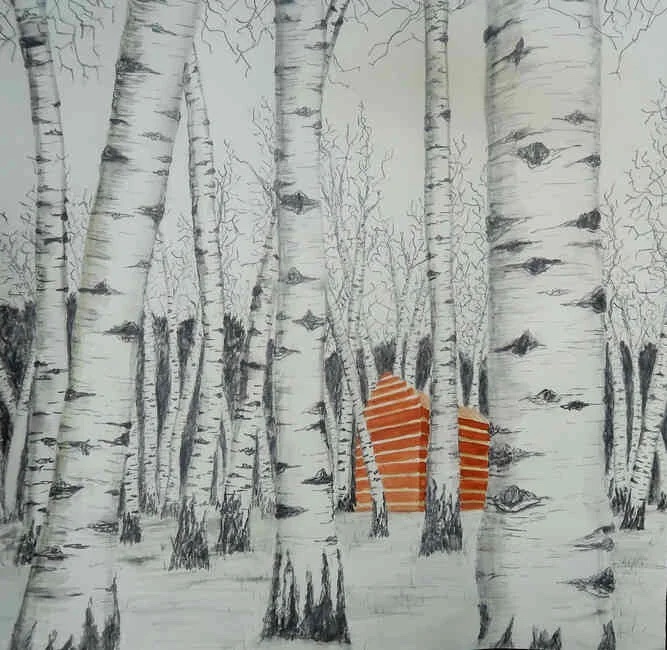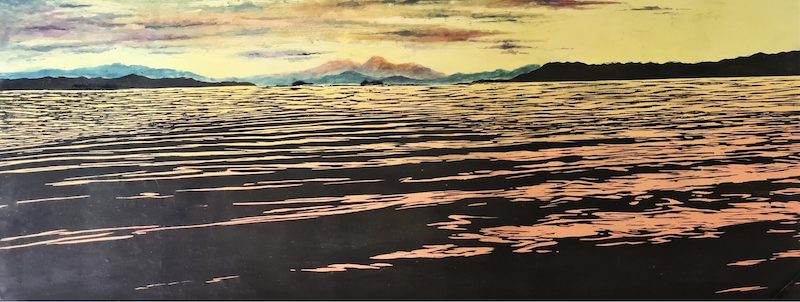In all the years I’ve been helping artists build their careers, I can say with a good deal of confidence that there are 4 clear steps to kick-start a rewarding art career and business.
1. Devote yourself to a studio practice.
A few nice pieces that your mom and best friends approve of aren't going to cut it. You must have an insatiable level of curiosity and a deep desire to share your voice with the world, which inspire you to get in the studio and make stuff.
While I don’t believe that an artist needs an art degree to succeed, I do know that art school gives artists a leg up on creating the habit of being in the studio. If no one instilled this in you, it’s something you need to figure out.
Like anyone who is self-employed, no one is going to tell you when to get up, when to go into the studio, when to take a break, when to stop for the day, or when to take a vacation. These are things you must learn to do for yourself.
The great thing about being self-employed is that you are free to organize your schedule so that it works for you. The downside is that some people aren’t very good at setting goals and boundaries. If this is you, don’t use it as an excuse. Consider it a challenge to change your ways.
2. Start pulling together a mailing list.
As I say in I’d Rather Be in the Studio! …
Your mailing list (a.k.a. “contact list”) is your most important asset.
No one knows the same people you do. The people you know—regardless of whether or not they are part of the art cognoscenti—will help you succeed. And no one can succeed on his or her own.
In the simplest terms, a mailing list contains names and contact information of people you know or might like to know. For artists, a mailing list usually begins with friends and family, and then expands to buyers and potential buyers. You use your mailing list to stay in touch with all of these people–to keep them informed of your goings-on.
In a nutshell, your mailing list—something unique to you and your career—is the primary tool you use to share your art with the world. As you may know, I think sharing in a sincere way is much easier and much more effective than trying to sell.
These days, the artist’s mailing list contains both brick-and-mortar addresses along with email addresses and phone numbers. For these reasons, it might better be called a contact list. You need all three types of information in order to keep your name in front of people and to conduct critical follow-up.
The longer you wait to begin or to update your mailing list, the more work you make for yourself. You don’t want to have something to tell everyone and then have to carve out time to input names into your computer.
A mailing list is something every artist can do regardless of experience because you already know people.
[ See Establish Yourself: Essentials for Artist Success ]
And you're about to meet more because of the next step.
Every new artist needs to build a strong business foundation to support their growth.
No need to guess. I've pulled the essentials together for you in a single program.
3. Connect with other artists.
Many artists do not have sideline cheerleaders in the form of friends or family. Some people just don’t get us! If you’re in this predicament, you must seek or establish your own cheering squad.
[ I invite you to find support, accountability, and business strategies in the Art Biz Connection. ]

Without some kind of support system, you will find yourself beaten down and constantly on the defensive. Sometimes you can obtain such support by getting involved in existing artist organizations. If you aren’t familiar with one in your area, contact your local or state arts council, which you can find in the resources of the National Assembly of State Art Agencies.
Being around other artists builds your confidence and sustains you emotionally. In addition, you will hear about opportunities you never knew existed if you hadn’t been part of a group. You’ll hear about them before they are ever published!
You will also be eligible to apply for grants, awards, and exhibitions sponsored by the organization; be introduced to new art products and materials; and receive business advice in many areas (software, accounting, taxes, copyright, and more).
Most importantly, with the right organization, you’ll make contacts that lead to the next step on your career path, many of which will become your friends for life.
Look for the Right Artist Organization
Before you join an organization, make sure it’s a good fit for you. Don’t join just for the sake of joining, which can end up being a waste of time and money. Attend meetings as a guest and consider where you might fit in.
Before you join an organization, you should conduct research. (A complete checklist of questions to ask is in the book, page 163-64.)
You aren’t joining just to be a member. You are joining to become involved. If you’re uncomfortable in an organization, you won’t reap the benefits of your membership. If you can’t find the right fit in an existing organization, bring together a group of artists who meet regularly for the purpose of supporting each other.
The more you’re connected with other artists, the more opportunities you’ll discover.
4. Develop a habit of writing about your art.
You will need words to share your art with others.
Ever heard of anything anywhere being sold without words? You need words to talk with interested buyers, other artists, curators, and arts writers. You need words to fill up a website or blog.
You need words to add to your images on social media or to speak in a video or artist talk. And you need words to write your artist statement, press releases, grants, and newsletters.
You can't suddenly sit down at your computer or stare at a blank sheet of paper and expect to come up with a brilliant artist statement, bio, press release, or cover letter. You have to work at it.
I can't think of a better way to begin the process than to start a journal. No one has to see your journal writing, so you can unload whatever is on your mind. It's a tool you use along the way to help you connect with bigger and better audiences. The equation goes something like this.
More writing = more words = more opportunities to connect with fans
Make up rules for your journaling as you go along. Or skip the rules and just enjoy your time with the pen and paper.
Do you need to create discipline? Set aside 15-20 minutes in the morning or evening to write.
Do you have ideas leaking from your pores? Keep a journal with you at all times to capture the ideas before they disappear. Or use a voice recorder to catch your thoughts.
When you journal, you're not trying to craft the perfect sentence. You're writing just to get the words out of your head and onto the paper. You're writing to capture the thoughts and to create a pool of words you can fish from when you need them. And you WILL need them.
You can’t promote your art without words, so you might as well start now. Writing might also make you a better artist because you’re exploring art at a deeper level.
Your devoted studio practice (#1) will result in plenty of ideas for your journaling.
As you are connecting with new people (#3), you will be more confident in sharing your art because you have taken the time to explore its deeper meaning.
This post was first published on August 12, 2009 and has been updated with original comments intact.
Every new artist needs to build a strong business foundation to support their growth.
No need to guess. I've pulled the essentials together for you in a single program.





26 thoughts on “The First 4 Steps Toward Selling Your Art”
Alyson – This is a great post. Writing is so important to communicating about my work and can inform what I am trying to accomplish creatively. I have had many paintings result from journal entries – and I paint realism.
It is also a way I can share my excitement about what I paint and why. Blogging has been a fantastic tool for the practice of writing and connecting with other artists and collectors.
Thank you so much for this great series of articles. I have enjoyed tremendiously reading them. It is always great being reminded and adding new knowlegde. I actually find the writing bit hard. Not that I don’t have anything to say, but not having English a my first language is deffinately not an advantage. Ah well, I’m doing my best… 🙂
Birgitte
Writing about your art is extremely important. Since I attended Alyson’s workshop a couple of years ago I began a blog, newsletters, brochures, social networking (FB, Linkedin, Twitter), joined forums, improved my artist statement and bio; wrote proposals, the list goes on. By doing so I’ve been better able to explain what I do and why verbally in person, too, and with more confidence.
Alyson,
Thanks for your useful and very important tips.
-ML
I think the writing should be left to pros…Let the artists paint & create–The key to sales is having a PR & marketing team to write about you…and sell your work. It holds much more creditbility when it comes from the press and third parties…
Artpeace!
AUDREY /ARTV
I finally started an art blog-
http://philipkochpaintings.blogspot.com
– and find it has been remarkably enjoyable. Wonder why I was so slow to pick up the pen in the first place. The only caution I have is that it does take up some of your time.
–
I have found that journaling about my work (for my eyes only) helps me to firm up what I’m trying to say with paint. As someone who is forever looking to solidify my Visual Voice, I find having that “conversation with myself” helps me to whittle away at where I’m trying to go. After painting or facing a painting problem, I spew out all phrases and comments that come to mind. As I start to weed through them, I can sometimes find what I’m really trying to say. Though, I must admit, I’m in love with words almost as much as I’m in love with the visuals! 🙂
I agree with you about how it is important for an artist to become a good writer. I taught myself how to express myself verbally as well as I do visually by forcing myself to write about every single piece of art that I create. English is not even my first language, so I somewhat struggled for a while, but eventually writing about my work became as natural to me as creating it.
Pingback: Beyond spring cleaning: sell, sell, sell : Jewelry and Beading - Jewelry Making and Beading
I like Natasha’s idea of writing about every single piece of art as a practice. Both writing about and talking about my art has been a breakthrough. I am realizing how important and powerful these are to my career. Unless I can give life and validity to my art, how can I expect someone else to?
Thanks for the push, Alyson!
Philip: Welcome (a bit late) to the blogging world.
Tracy: Sounds like words are part of your process. Very nice!
Natasha and Julie: Writing about every work is wonderful. That’s why blogs are great! You can use that text, too, on a website. You never know which work someone will ask you about, so you’ll be well prepared.
Alyson,
i love the insights. I finally started writing my blogs on meylah. I definately can relate to it. I love your statement “More writing = more words = more opportunities to connect with fans”
This is the real truth. I wrote 2 blogs and I have got great feedback from fans.
your writing is wonderful.
Checkout my 2nd blog and let me know your advice : http://meylah.com/blog/82/Throwing-a-Home-Jewelry-Party
I hope you don’t mind my asking, but is Meylah free to use? I was looking over the site and found that one can request an invite. However, I didn’t see anything else about the trial period. Thank you. 🙂
LIza: You’ll have better luck contacting Courtney through her blog. Not everyone comes back to review older comments.
Really great advice actually. I never thought about it that way, not even art sells it self without words. Thanks so much, I’m going to make a conscious effort to write about my work.
Alyson what a fantastic post! Thank you so much! Your research is fantastic! I have kept a hand written log for years and years. I eventually moved it onto Exel and now I found Artists software! I love that! Thank you!
I started blogging about digital collage techniques, with specifics about the use of vintage wood engravings, inspiration, etc. It can be viewed at http://blog.retrocollage.com/.
What I wonder is whether is makes sense to mix postings of new art in this type of blog? I do have a link to my art gallery of work for sale but have not put artwork itself in the blog feed.
Eric: You could probably link the past to the present with a little effort.
A number of your links on your home page didn’t work for me.
Alyson: Thanks for your feedback. My tech person fixed the problem with a setting, and the website should be working now. I appreciate the alert.
Alyson: I started posting replies with the name of my website rather than my own name (Eric Edelman). I also decided to integrate my own artwork with my writings. Recently, I began a series I call “Profiles in Collage” to highlight the background of the earlier collage masters. So my blog is a hodgepodge of art-related, collage-focused material.
I find now it does take quite a while to research and write my blog posts, but I think it is worth it.
I really wish you’d use your own name as that’s how you’ll want to be known in history. With “Art of RetroCollage,” you could be anyone. And we’ll just call you “Art.”
Michele: I’m happy you’ve been moving forward. And it sounds like you’re enjoying it – half the battle!
I didn’t know where else to write this, I read your posts regarding facebook and twitter…I hope you’ll consider writing something soon regarding LinkedIn as well. Thanks!
Tim: You can always email me (link in the About tab above).
I haven’t heard of artists having much luck with LI and I hate to encourage anyone to spend time somewhere that won’t be fruitful for them. I’d love to hear from you if you have a good LI case study. alyson@artbizcoach.com
Pingback: Connect with other artists — Art Biz Blog
Hi Alyson, thank You for your timely post. The words “back to basics” come to mind as I read these tips. Your statement, “More writing = more words = more opportunities to connect with fans” is so true. I used to journal and blog regularly and though I always struggled with writing, I found the process of regular journaling gave me confidence and the story/ideas came quicker when I sat down to write my blog posts. I stopped doing both over the past few months and I recognize how much I struggle with any writing. I’ve taken up journaling again and blogging is next! (I used to enjoy it.)